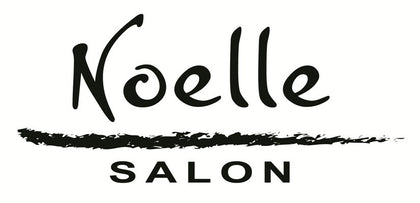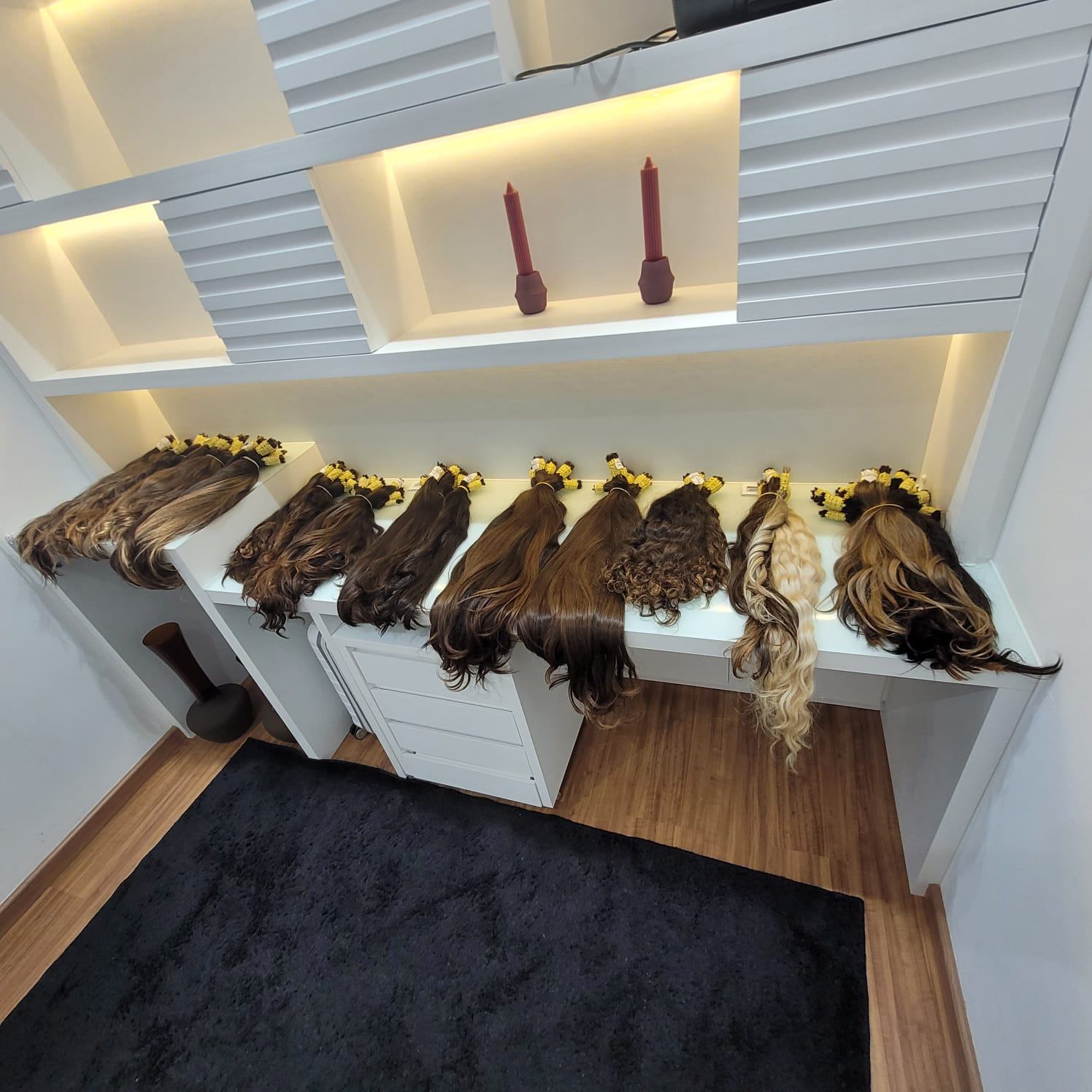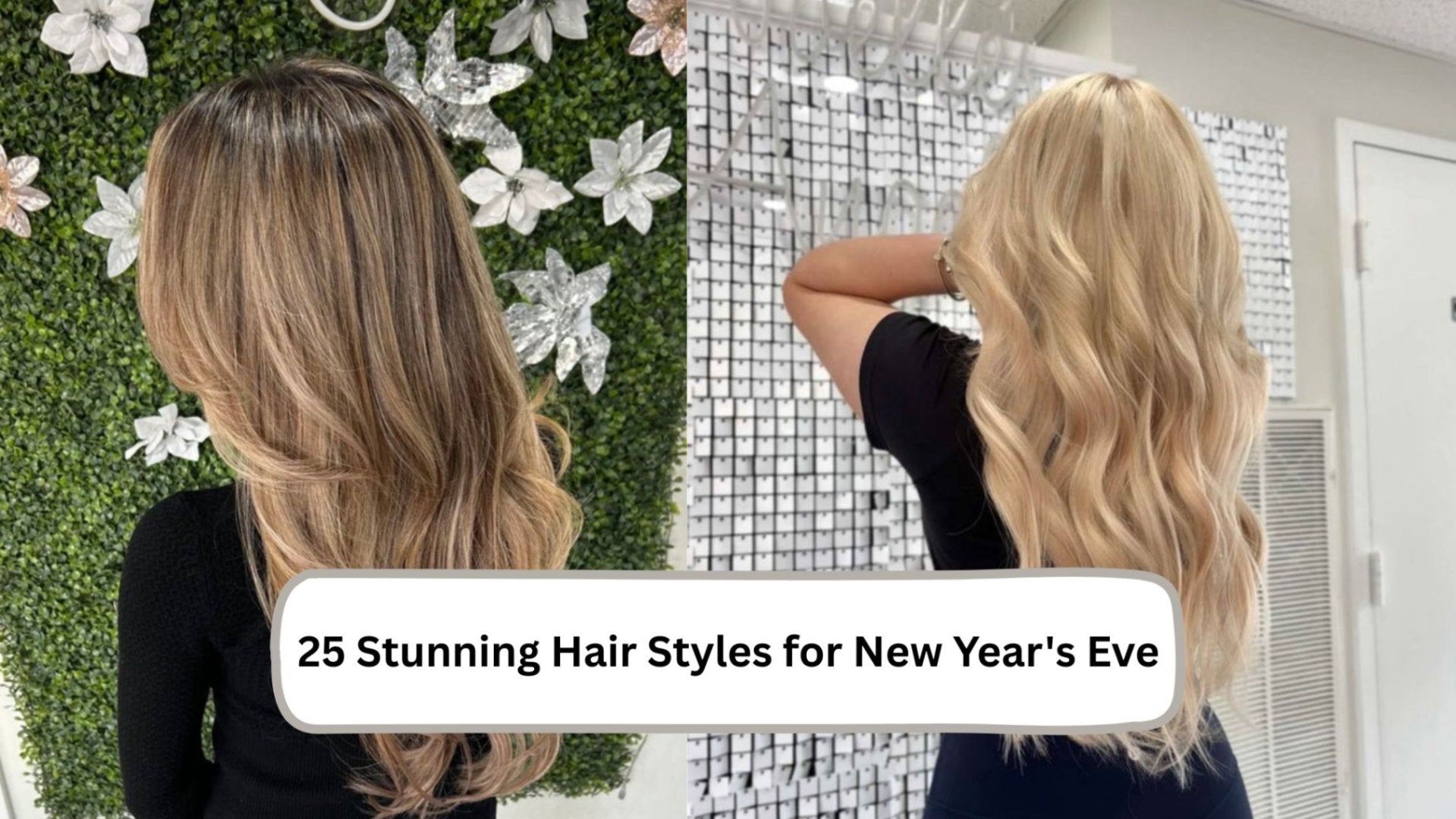What Are Synthetic Hair Extensions Made Of? A Complete Guide
Key Highlights
-
Synthetic extensions use fibers like acrylic, polyester, nylon, Kanekalon, and Toyokalon.
-
Kanekalon stands out as the most natural-looking synthetic option.
-
Human hair, especially Remy, lasts longer and styles freely.
-
Beads and attachments are usually metal or plastic with silicone lining.
-
Human hair offers better blending, comfort, and value than synthetic.
Ever picked up a set of extensions and wondered what’s really in those strands? For many, the thought of clipping, bonding, or beading something unknown into their hair feels a little unsettling. The truth is, not all extensions are made the same, and that difference can mean a flawless finish or a frustrating mess.
Some extensions come from real human hair, cut and sorted strand by strand. Others are crafted from synthetic fibers, designed to mimic the look and feel of natural locks. But what are synthetic hair extensions made of, and how do they compare to real hair? That’s where things get interesting.
This guide breaks it down in plain terms, so you’ll know exactly what’s in your hair before it ever touches your scalp.
What Are Synthetic Hair Extensions Made Of?

Synthetic hair extensions are made of man-made fibers. Yes, those shiny strands are spun from man-made fibers like acrylic, nylon, or polyester.
You’ve probably heard of Kanekalon or Toyokalon. They’re the big players in the synthetic world. They’re textured, colored, and styled to trick the eye into seeing real hair.
The catch? Heat tools aren’t their best friend. Most synthetic fibers can’t handle high temperatures without melting. They look good out of the box, but styling freedom is limited. Think of them as a budget-friendly option that delivers the look, but not the same feel or flexibility as real hair.
What Are the Core Materials Used in Synthetic Hair Extensions?

Synthetic hair might look simple on the outside, but every strand starts with science. These extensions are built from specialized plastics, melted and spun into fine filaments designed to mimic human hair. The most common fibers are acrylic, polyester, and nylon, each with its own personality.
These materials determine how the hair looks, feels, and holds up over time. Let’s break them down one by one.
1. Acrylic Fibers
Acrylic is the go-to material for many high-quality synthetic extensions, including Kanekalon. It’s soft, lightweight, and has just the right amount of shine to look realistic without appearing overly glossy.
Because it mimics natural hair so well, acrylic is a favorite for braids and everyday styles. It’s easy to manage, comfortable to wear for long hours, and gives that salon-fresh look without the salon price tag.
2. Polyester Fibers
Polyester is the workhorse of synthetic hair. It’s tough, versatile, and built to last. It holds color beautifully, so your extensions stay vibrant for longer without fading.
The trade-off is that polyester tends to be shinier than real hair, especially under bright light. It's a popular choice for budget-friendly extensions, but it doesn't always deliver the most natural finish.
3. Nylon Fibers
Nylon brings strength and flexibility to the table, making extensions lightweight and comfortable to wear. It can give you that easygoing, natural flow you want without weighing your hair down.
But here’s the catch: nylon is sensitive to heat. It frizzes easily and can melt if you’re not careful with styling tools. That’s why it’s often blended with acrylic or polyester to balance out its weaknesses.
What Are Hair Extension Beads and Attachments Made Of?
When it comes to attaching hair extensions, the fibers aren’t the only thing that matters. The beads and attachments play a huge role in comfort, durability, and hair health.
Both micro beads and nano beads are commonly used, and they can be made from a variety of materials.
-
Aluminum, copper, or stainless steel for strength and hold.
-
Silicone lining for added grip and protection of natural hair.
-
Plastic options for lightweight, budget-friendly applications.
The main difference between micro beads and nano beads is their size. Nano beads are smaller, which makes them less visible in fine hair, but the actual materials used to create them are usually the same.
The right bead keeps your natural hair safe, ensures a longer hold, and makes the extensions feel comfortable from day one.
What Is the Best Type of Synthetic Hair?

Not all synthetic hair is created equal. Some feel cheap and plasticky, while others look surprisingly close to natural hair. If you’re curious about the differences, here are the main types you’ll come across.
1. Kanekalon
Kanekalon is often considered the best type of synthetic hair. It has a softer texture, less shine, and looks much closer to real human hair compared to lower-quality fibers.
It also holds styles well, and premium versions can even handle low-heat styling. That is why Kanekalon is the top choice for realistic synthetic extensions.
2. Toyokalon
Toyokalon is another popular fiber, especially for braids and curly looks. It is lightweight, smooth, and has a silky finish that gives extensions a natural bounce.
Because it is softer than many synthetics, it feels more comfortable to wear and blends better with natural hair.
3. Futura Fiber
Futura is a newer, heat-resistant synthetic option. Unlike traditional fibers, it can handle low to medium heat styling tools, giving you more flexibility.
It is ideal for people who want synthetic extensions but do not want to give up the ability to curl or straighten their hair occasionally.
4. PVC (Polyvinyl Chloride) Fibers
PVC fibers are on the lower end of the scale. They are cheap, stiff, and have a shiny, plastic look that makes them easy to spot.
These are often used for costume wigs or temporary styles, but they are not a great choice for long-term wear.
5. High-Temperature Synthetic Blends
Blended fibers are designed to improve on older synthetic options. They combine different materials to create strands that are more durable and slightly heat-resistant.
These blends often strike a balance between cost and performance, making them a decent choice for mid-range synthetic extensions.
Kanekalon is still the best for a natural look, while Toyokalon and Futura are solid alternatives depending on your style goals.
Are the Highest Quality Extensions Made of Synthetic Hair?

Ever grabbed a pack of extensions and thought, “Wow, these look good... but will they last?” You’re not alone. Many people wonder if the highest quality extensions are made of synthetic hair. The truth is, they’re not. Premium extensions are crafted from human hair, especially Remy hair, because they deliver the look, movement, and styling power synthetic strands simply cannot match.
Let’s break it down so you can see why real hair still rules.
1. Durability and Lifespan
Extensions aren’t meant to be a two-week fling, you want them to stick around.
-
Human hair extensions, particularly Remy, can last 9 to 12 months with the right care.
-
Synthetic strands usually fade fast, holding up just 1 to 3 months with frequent wear.
-
Over time, synthetic fibers lose their shine, tangle more, and turn frizzy.
If long-lasting wear matters, human hair is the only safe bet.
2. Styling Flexibility
Your hair should never limit your style, it should fuel it.
-
Human hair can be curled, straightened, colored, and restyled freely.
-
Synthetic fibers are far less forgiving and cannot handle chemical treatments.
-
Even heat-resistant synthetic extensions have strict limits before they melt.
When it comes to versatility, real hair extensions win every single time.
3. Natural Movement and Texture
Hair shouldn’t just look real, it should move real.
-
Human hair flows naturally, with shine and bounce that blends seamlessly.
-
Synthetic extensions often look stiff or overly glossy under light.
-
That is why when people ask what are Bellami hair extensions made of or what are Luxy hair extensions made of, the answer is cuticle-intact human hair.
Natural texture is the secret that makes high-quality extensions believable.
4. Maintenance and Blending
Nobody wants hair that screams high maintenance or refuses to blend.
-
Human hair extensions can be washed and conditioned just like your own.
-
Synthetic hair needs special, mild products and extra caution.
-
Human hair blends more seamlessly with natural strands, making it almost undetectable.
For low-fuss care and flawless blending, real hair is the clear winner.
5. Value and Cost Over Time
Cheaper isn’t always better, especially for hair.
-
Synthetic extensions cost less up front but need frequent replacements.
-
Human hair costs more initially but lasts longer and looks natural the whole time.
-
The value per wear is far higher with Remy human hair.
If you’re thinking long-term, human hair extensions are the smarter investment.
What Are Real Hair Extensions Made Of?

If you have ever asked yourself, “Are hair extensions made of real hair?” the answer is yes. The highest quality ones are. Real hair extensions are crafted from 100% human hair, which means they have the same keratin protein structure as your natural strands. That is why they look, move, and style just like your own hair.
Let’s take a closer look at how real hair extensions are made and what sets them apart.
1. Human Hair Structure
Real hair extensions start with keratin, the same protein your natural hair is built from. That’s what makes them look, feel, and move just like your own strands.
The magic is in the cuticles. When they stay intact, the hair keeps its shine, resists tangling, and feels silky smooth. With the right care, you get extensions that stay strong and natural-looking for the long haul.
2. Remy Hair Extensions
What is remy hair extensions made of? Well, Remy extensions are the gold standard of human hair because every strand is carefully aligned.
The best part? Remy hair holds its shine and softness for longer and loves a little styling. You can curl it, color it, or straighten it without worry. That’s why Remy extensions are the top pick for anyone who wants premium, natural-looking hair that lasts.
3. Non-Remy Hair Options
Not all human hair extensions are Remy. Non-Remy hair often has cuticles stripped or misaligned, which means it looks great at first but tangles much faster.
It’s usually more affordable, but it doesn’t hold up as long. While it still counts as real hair, it just can’t deliver the same smooth, premium feel as Remy.
4. Blending and Styling Power
One of the biggest perks of real extensions is how seamlessly they blend with your natural hair. Once they’re in, they move, shine, and style exactly like your own strands.
Whether you want to curl, color, or straighten, you’ve got total freedom. And since they hold up so much better than synthetics, you'll enjoy that flawless finish for far longer.
Also read: Human vs. Synthetic Wigs & Hair Toppers
Human Hair Extensions vs Synthetic Hair Extensions

Choosing between human hair and synthetic extensions comes down to what matters most to you: natural look, styling freedom, budget, or convenience. Here’s the full breakdown:
|
Feature |
Human Hair Extensions |
Synthetic Hair Extensions |
|---|---|---|
|
Material |
100% human hair (keratin protein structure) |
Man-made fibers like acrylic, nylon, polyester, Kanekalon, Toyokalon |
|
Look & Shine |
Natural shine, realistic flow, blends seamlessly |
Often too shiny or plasticky, stiffer under light |
|
Texture & Movement |
Moves, bends, and bounces like natural hair |
Stiff, limited movement, less realistic feel |
|
Styling Options |
Can curl, straighten, blow-dry, and even color |
Limited — most cannot handle heat or dye; heat-resistant versions have strict limits |
|
Durability & Lifespan |
9 to 12 months (Remy hair can last longer) |
1 to 3 months with frequent wear |
|
Maintenance |
Can be washed, conditioned, and treated like natural hair |
Requires special care and mild products; standard shampoos may cause damage |
|
Blending |
Blends flawlessly with natural strands |
Often harder to match texture and tone |
|
Comfort |
Lightweight, natural feel on scalp |
Can feel heavier, less breathable |
|
Cost |
Higher upfront cost but better long-term value |
Cheaper upfront but needs frequent replacement |
|
Value per Wear |
Long-lasting investment, better ROI |
Short-term, less value over time |
|
Safety Concerns |
Generally safe if ethically sourced and processed |
Some fibers (like low-quality braiding hair) may contain harmful chemicals |
|
Best For |
Everyday wear, professional use, clients wanting natural and versatile styles |
Temporary looks, budget-friendly options, short-term style changes |
|
Examples/Brands |
Bellami, Luxy, Veila, Great Lengths (all human hair based) |
Costume wigs, budget packs, heat-resistant synthetic braids |
If you want the most natural, versatile, and long-lasting extensions, real human hair wins hands down. Synthetic extensions are fun for temporary style changes, but they can’t compete with the performance and quality of real hair.
At Noelle Salon, we sell both human and synthetic extensions to suit every style and budget. For those who want the most natural look and flexibility, our premium Veila Hair Extensions are unmatched. But if you need a temporary or budget-friendly option, we carry high-quality synthetic styles as well.
Ready to find the perfect match? Book your free consultation with Noelle Salon today and let us help you choose what works best for you.
Why Choose Noelle Salon for Your Extensions?
Struggling with extensions that don’t blend, slip out too soon, or damage your natural hair? You’re not alone. Many clients come to us after bad experiences with low-quality hair or improper application. The good news is, it doesn’t have to be that way.
At Noelle Salon, we take the guesswork out of hair extensions. Whether you want long-lasting human hair or a temporary synthetic option, our team helps you choose what works best for your lifestyle, budget, and hair health.
Here’s why clients trust us:
-
Over 35 years of expertise in hair extensions and non-surgical hair replacement.
-
Wide variety of options including premium Veila human hair and quality synthetic extensions.
-
Same-day services so you can walk out with a new look instantly.
-
Safe, comfortable applications designed to protect your natural hair.
With Noelle Salon, extensions aren’t just about adding length, they’re about giving you confidence and style that lasts.
Ready for flawless extensions? Book your free consultation at Noelle Salon today.
Conclusion
Synthetic and human hair extensions each have their place. From the materials used to their durability and styling options, knowing the difference helps you make a smarter choice that matches your style, budget, and needs.
The next step is simple: think about how often you’ll wear extensions, how much flexibility you want in styling, and how long you expect them to last. Once you have your priorities clear, choosing the right type of extensions becomes much easier.
FAQs (Frequently Asked Questions)
Are synthetic hair extensions hypoallergenic and safe for sensitive scalps?
Synthetic extensions are generally safe, but not hypoallergenic. Since they are plastic fibers, some may irritate sensitive scalps. Before choosing any type of hair extensions or application techniques like micro rings, test a few strands first.
How does the material affect the durability and look of synthetic hair extensions?
The material defines everything. Premium fibers mimic natural strands of hair and last longer, while cheaper plastics frizz and tangle. Just as Brazilian hair or micro loop hair extensions vary, the type of hair extensions dictates results.
Can synthetic hair extensions be recycled or reused?
Most synthetic extensions cannot be recycled due to coatings and mixed fibers. Limited reuse is possible with careful application methods, but unlike cold fusion or other attachment methods for human hair, synthetic fibers are short-term and less durable.
What are hair extensions made out of?
Hair extensions are made from either 100% human hair or synthetic fibers like acrylic, polyester, or nylon. Premium extensions use Remy human hair, while budget options often rely on synthetic materials.
What are hair extension beads made of?
Hair extension beads are typically made of aluminum or copper for strength, ofte lined with silicone for protection. Some are plastic, offering a lightweight and budget-friendly option, though metal beads are more durable.
What are Belle hair extensions made of?
Belle hair extensions are made from 100% Remy human hair, with cuticles aligned to reduce tangling. This makes them soft, natural-looking, and more durable compared to synthetic alternatives.
What are fusion hair extensions made of?
Fusion hair extensions are made from real human hair and attached using keratin bonds. The keratin is melted with a heat tool to fuse the extensions securely to natural strands.
Are some types of hair extension beads hypoallergenic?
Yes, certain beads are more scalp-friendly. Silicone-lined micro rings and nano beads reduce irritation by protecting strands of hair. Choosing the right attachment method and bead type is crucial for sensitive scalps during application techniques.




